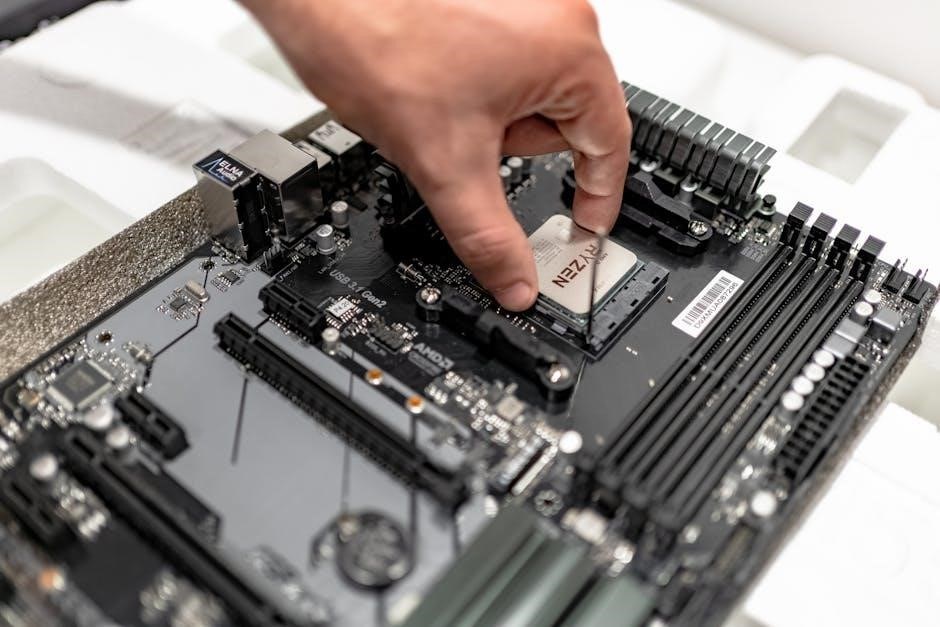Welcome to the Honeywell RTH221B Installation Manual. This guide provides step-by-step instructions for installing, configuring, and troubleshooting your programmable thermostat, ensuring optimal performance and ease of use.
1.1 Overview of the RTH221B Thermostat
The Honeywell RTH221B is a user-friendly, 1-week programmable thermostat designed to control heating and cooling systems efficiently. It operates on 24-volt or 750 mV systems, ensuring compatibility with most single-stage HVAC setups. The thermostat features a straightforward interface for setting schedules and adjusting temperatures, promoting energy savings and comfort. Its compact design and minimal wiring requirements make installation straightforward. This guide provides detailed instructions to ensure proper setup and optimal performance of your RTH221B thermostat.
1.2 Key Features of the RTH221B
The RTH221B thermostat offers a 1-week programmable schedule, allowing users to customize temperature settings for different days. It is compatible with single-stage heating and cooling systems and operates on 24-volt or 750 mV power. The thermostat features a user-friendly display screen, enabling easy adjustments and scheduling. It also includes advanced settings such as a filter reminder and dead-band adjustment for enhanced system efficiency. Designed for energy savings and convenience, the RTH221B is an ideal choice for homeowners seeking precise temperature control with minimal complexity.
1.3 Compatibility and System Requirements
The Honeywell RTH221B thermostat is designed for compatibility with single-stage heating and cooling systems, including gas, oil, and electric setups. It requires a 24-volt AC power supply and is not compatible with 120/240-volt systems or multi-stage conventional systems. The thermostat operates effectively with a minimum system voltage of 750 mV, ensuring reliable performance. Before installation, verify system compatibility to ensure seamless integration and optimal functionality of the thermostat. This ensures the RTH221B works efficiently with your existing HVAC setup.

Pre-Installation Requirements
Before installing the RTH221B, ensure you have the correct system voltage and compatibility; Gather all necessary tools and materials, and review safety guidelines to proceed smoothly.
2.1 Understanding the System Voltage Requirements
The RTH221B thermostat operates on 24-volt or 750 mV systems, ensuring compatibility with most HVAC setups. It is crucial to verify your system’s voltage before installation to avoid damage or malfunctions. This thermostat is not suitable for multi-stage conventional systems or 120/240-volt configurations. Always check your HVAC system’s specifications to confirm compatibility and ensure safe installation. Proper voltage matching is essential for optimal performance and longevity of the device, preventing potential electrical issues down the line.
2.2 Checking Compatibility with HVAC Systems
Before installation, ensure the RTH221B thermostat is compatible with your HVAC system. It works with gas, oil, or electric heating and cooling systems but is not compatible with multi-stage conventional systems or 120/240-volt setups. Verify your system’s specifications to confirm compatibility. This thermostat is designed for single-stage systems and operates on 24-volt or 750 mV power. Proper compatibility ensures safe and efficient operation, preventing potential installation issues. Always check your HVAC system type before proceeding with installation to guarantee a smooth setup process.
2.3 Gathering Necessary Tools and Materials
To ensure a smooth installation, gather the required tools and materials beforehand. You will need a screwdriver, drill, and wall anchors for mounting the thermostat. Additionally, have spare wires and connectors ready for any wiring adjustments. A voltage tester is essential to verify system voltage compatibility. Ensure all materials are compatible with your HVAC system type. Having these tools and materials prepared will save time and prevent delays during the installation process. Proper preparation is key to a successful and efficient setup of your RTH221B thermostat.
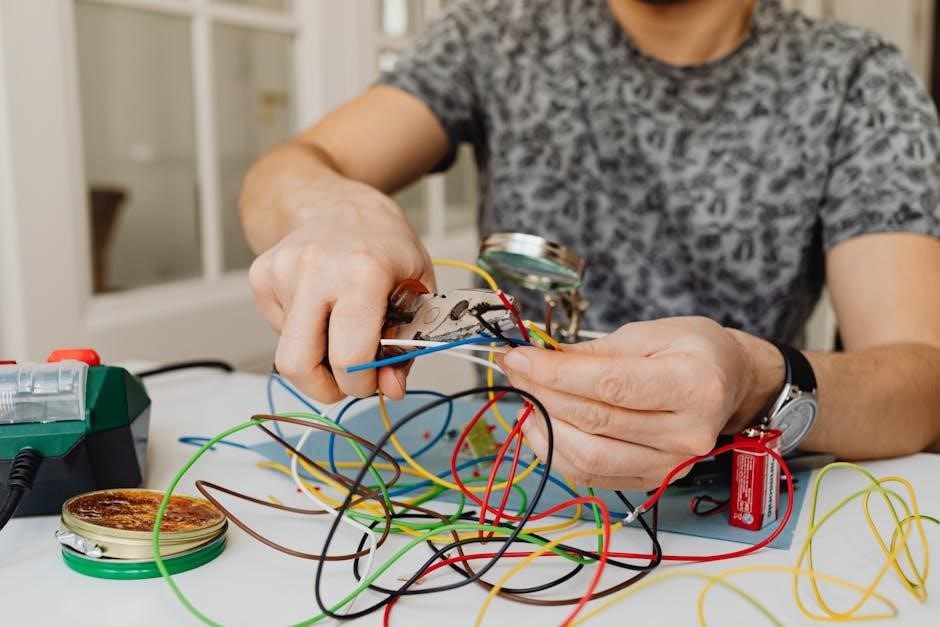
Installation Process
The installation process involves mounting the thermostat, wiring it to your HVAC system, and performing final checks to ensure proper functionality and system compatibility.
3.1 Mounting the Thermostat
Mounting the RTH221B thermostat involves preparing the wall and securing the device. Start by removing the old thermostat and noting the wiring configuration. Drill holes at the marked positions on the wall and insert the supplied anchors. Gently level the thermostat for proper alignment, ensuring it is straight and secure. Attach the thermostat base to the wall anchors using the provided screws. Tighten firmly but avoid over-tightening to prevent damage. Once mounted, ensure the thermostat is level for aesthetic purposes, though this does not affect functionality. Dispose of the old thermostat responsibly.
3.2 Wiring the RTH221B Thermostat
Wiring the RTH221B thermostat requires careful attention to ensure compatibility with your HVAC system. The thermostat operates on 24V systems and is compatible with gas, oil, or electric heating and cooling systems. Begin by turning off the power to your HVAC system at the circuit breaker. Match the wires from your existing system to the thermostat’s terminal labels (e.g., R, W, Y, G, C). Connect each wire securely to the corresponding terminal on the RTH221B. Double-check all connections for accuracy. Finally, restore power and test the system to ensure proper functionality. Avoid connecting it to multi-stage conventional systems or 120/240V systems, as it is not compatible.
3.3 Advanced Wiring Configurations
For advanced setups, the RTH221B supports configurations like heat pumps and zone control systems. Ensure the thermostat is connected to a 24V or 750mV system, as it does not support multi-stage conventional systems or 120/240V setups. Use the terminal labels (R, W, Y, G, C, etc.) to connect wires according to your HVAC system type. For heat pumps, verify the correct wiring of the reversing valve. If using zone controls, ensure proper wiring to maintain system functionality; Always consult a professional if unsure about complex configurations to avoid system damage or safety risks.
3.4 Final Installation Checks
After completing the installation, perform a thorough check to ensure everything functions correctly. Turn on the power to the HVAC system and test both heating and cooling modes to confirm proper operation. Check the thermostat’s display for clarity and responsiveness. Verify that the thermostat is level for proper operation. Ensure all wiring connections are secure and match the system requirements. Finally, review the manual to confirm all settings are correctly configured and the filter reminder is enabled if desired. This step ensures a safe and efficient setup.

Initial Setup and Configuration
Set the time, date, and basic settings to start using your thermostat. Navigate through the menu to customize temperature preferences and ensure all configurations match your HVAC system.
4.1 Setting the Time and Date
To ensure proper operation, set the time and date on your RTH221B thermostat. Press the “Menu” button and navigate to “Set Clock” using the navigation arrows. Select the current time format (12 or 24 hours) and use the arrows to adjust the hour and minutes. Set the correct date by scrolling through the month, day, and year options. Confirm your settings to save. Accurate time and date are crucial for programming schedules and maintaining thermostat functionality. Refer to the display screen for confirmation.
4.2 Configuring Basic Settings
After setting the time and date, configure basic settings for optimal performance. Navigate to the “Settings” menu and adjust temperature range, system type (heat/cool), and fan operation. Set the desired temperature range for both heating and cooling modes. Choose between automatic or manual fan control. Ensure the system type matches your HVAC setup. Additionally, select the temperature display format (°F or °C). Save your settings to apply changes. These configurations ensure the thermostat operates according to your preferences and system requirements. Refer to the display screen for confirmation of saved settings.
4.3 Understanding the Display Screen
The RTH221B features a clear LCD display showing time, temperature, and system status. Icons indicate active modes such as heating, cooling, or fan operation. The display also shows the current schedule period and setpoint temperatures. A backlit screen ensures visibility in low-light conditions. The display provides alerts for system status changes or maintenance reminders, such as “Change Filter.” Familiarizing yourself with the display symbols and messages helps you monitor and control your thermostat effectively, ensuring your HVAC system operates as intended.

Programming the Thermostat
Efficiently program your RTH221B to maintain optimal temperatures with a weekly schedule, customize settings, and override schedules as needed for flexibility and energy savings.
5.1 Creating a Weekly Schedule
Creating a weekly schedule on your RTH221B thermostat allows you to customize temperature settings for different days and times. Follow these steps:
- Press Menu to access the programming options.
- Select the day(s) you want to program (Monday-Sunday).
- Set the time periods and desired temperatures for heating and cooling.
- Adjust the settings to match your daily routines for energy efficiency.
- Save your changes to apply the schedule.
This feature ensures consistent comfort while optimizing energy usage.
5.2 Customizing Temperature Settings
Customizing temperature settings on your RTH221B thermostat allows you to tailor comfort levels to your preferences. To adjust settings:
- Press Menu and navigate to Temperature Settings.
- Use the Up and Down arrows to set your desired temperature for heating and cooling modes;
- Customize settings for specific times or events to optimize energy usage.
- Save your changes to ensure the thermostat operates according to your preferences.
This feature ensures precise control over your home’s temperature, enhancing both comfort and energy efficiency.
5.3 Overriding the Schedule
To override the scheduled temperature settings on your RTH221B thermostat:
- Press the Hold button to temporarily override the current schedule.
- Use the Up or Down arrows to adjust the temperature to your desired level.
- The thermostat will maintain this temperature until the next scheduled setting or until you press Run Schedule to resume programming.
- Overriding is ideal for temporary adjustments without altering the entire schedule.
This feature provides flexibility for unexpected changes or special events while preserving your programmed settings.
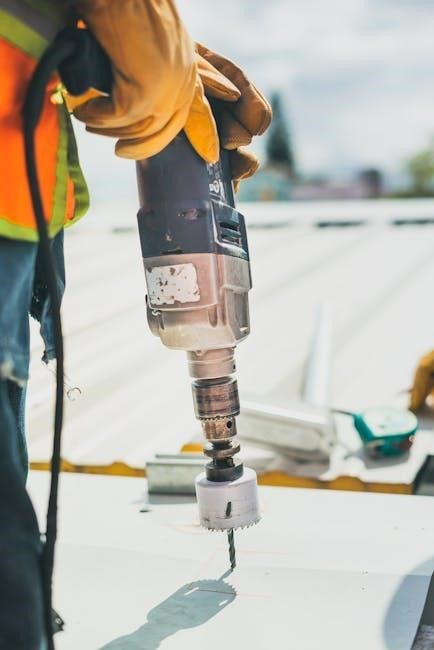
Advanced Features and Settings

Explore advanced features like the filter reminder, dead band adjustment, and system setup configuration to customize your RTH221B thermostat for enhanced performance and energy efficiency.
6.1 Enabling the Filter Reminder
To enable the filter reminder on your RTH221B thermostat, navigate to the system setup menu. Select the “Filter Reminder” option and choose the interval (e.g., every 30 days) for the “Change Filter” alert to appear. This feature helps maintain your HVAC system’s efficiency by reminding you to replace the air filter regularly. Once set, the thermostat will display the reminder, ensuring optimal airflow and system performance. Adjust the interval as needed based on usage and manufacturer recommendations.
6.2 Adjusting the Dead Band
The dead band is the temperature range around your setpoint where the system does not cycle on or off. On the RTH221B, this range is typically 0.5°F to 3°F. To adjust it, go to the system setup menu and select “Dead Band.” Choose a smaller range for tighter temperature control or a larger range to reduce cycling. This adjustment helps balance comfort and energy efficiency, ensuring your HVAC system operates smoothly without unnecessary activations. Refer to the manual for precise steps to customize this setting effectively.
6.3 System Setup and Configuration
The RTH221B thermostat offers advanced system setup options to customize your HVAC configuration. Access the system setup menu to select options like heat pump or conventional systems. Ensure compatibility by choosing the correct system type (e.g., 24V or 750mV). Configure additional settings such as fan operation and filter reminders. Proper configuration ensures optimal performance and prevents system incompatibility issues. Refer to the manual for detailed steps to navigate and adjust these settings effectively, tailoring the thermostat to your specific HVAC needs for enhanced comfort and efficiency.
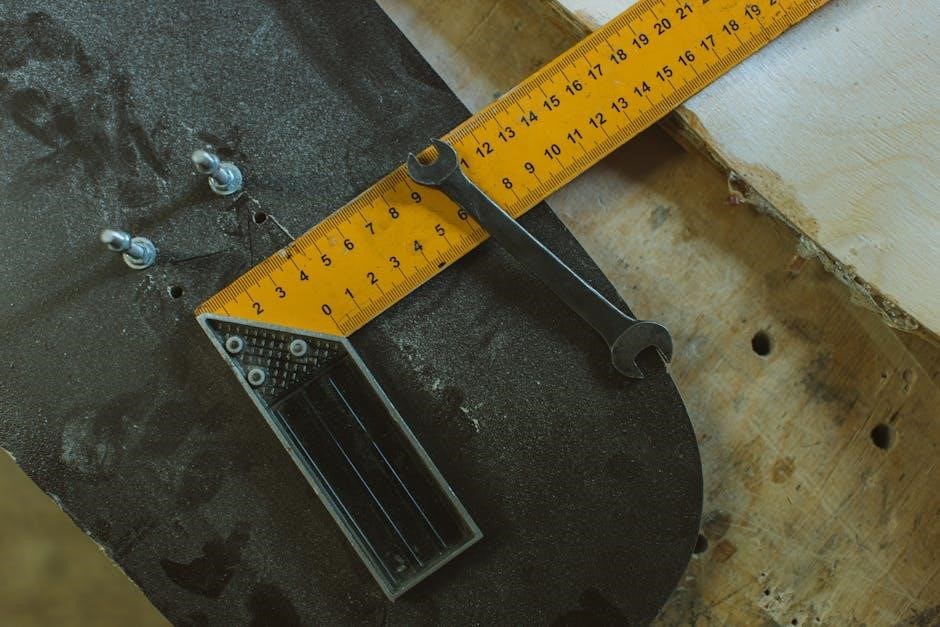
Troubleshooting Common Issues
Identify and resolve issues like display malfunctions or temperature inaccuracies; Check wiring connections, ensure proper system setup, and restart the thermostat if problems persist for optimal functionality.
7.1 Identifying Common Installation Errors
Common installation errors include incorrect wiring connections, improper leveling, and mismatched system compatibility. Ensure all wires are securely connected to the correct terminals and verify system voltage requirements. Leveling the thermostat ensures accurate temperature readings. Check for compatibility with your HVAC system to avoid operational issues. Consult the manual for specific guidelines and troubleshooting steps to address these errors effectively and ensure a smooth setup process.
7.2 Resolving Display and Programming Issues
Display and programming issues can often be resolved by resetting the thermostat or checking for loose wiring connections. If the display is blank, ensure the thermostat has power and the circuit breaker is not tripped. For programming issues, verify the time and date are set correctly. If the schedule is not saving, check for overrides or conflicts in the programming settings. Resetting the thermostat to factory defaults may also resolve persistent display or programming problems. Refer to the manual for detailed reset instructions.
7.3 Resetting the Thermostat
To reset the RTH221B thermostat, first switch off power at the circuit breaker. Remove the batteries and press the reset button located on the back of the thermostat. Hold for 5 seconds, then release. Reinstall the batteries and turn the power back on. This process restores factory settings, clearing all programmed schedules and preferences. After resetting, you will need to reconfigure the time, date, and temperature settings. This step is useful for resolving persistent software issues or preparing the thermostat for a new installation. Refer to the manual for detailed reset instructions.
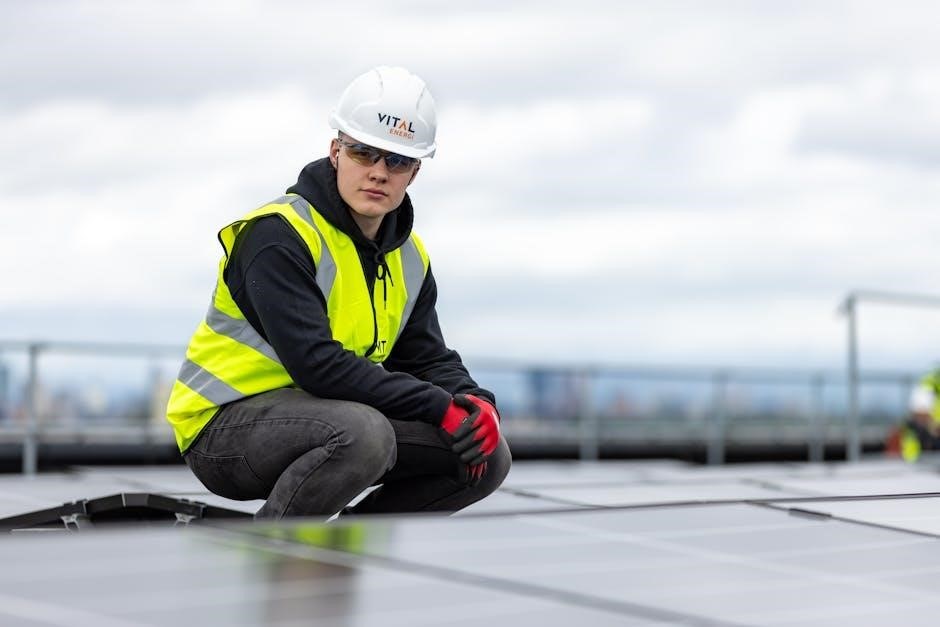
Maintenance and Support
Regularly clean the thermostat display and sensors. Replace batteries as needed. For assistance, contact Honeywell support or visit their website for troubleshooting guides and resources.
8.1 Regular Maintenance Tips
Regular maintenance ensures optimal performance of your RTH221B thermostat. Clean the display and sensors periodically to remove dust and debris. Replace batteries as needed to prevent interruption. Check wiring connections for secureness and inspect for any signs of wear. Update software if available to maintain functionality. Ensure proper leveling during installation for accurate temperature readings. Refer to the manual for detailed cleaning and inspection guidelines. Regular upkeep helps extend the lifespan and reliability of your thermostat, ensuring consistent heating and cooling performance.
8.2 Contacting Honeywell Support
For assistance with your RTH221B thermostat, contact Honeywell Support at 1-800-468-1502. Visit their official website at honeywellhome.com for troubleshooting guides, manuals, and FAQs. Support is available to address installation, repair, or replacement needs. Operating hours and additional contact methods can be found on their website. Honeywell’s dedicated team is ready to help resolve any issues, ensuring your thermostat operates efficiently and effectively.
8.3 Accessing Online Resources
Visit the official Honeywell website at honeywellhome.com for comprehensive online resources. Download the RTH221B installation manual, troubleshooting guides, and FAQs. Access video tutorials and user forums for additional support. For direct assistance, contact Honeywell Support via email or phone at 1-800-468-1502. Utilize these resources to resolve issues, understand advanced features, and optimize your thermostat’s performance. Online resources are available 24/7, ensuring you have the help you need whenever you need it.
By following this manual, you’ve successfully installed and configured your RTH221B thermostat. Refer to the final checklist and ensure optimal performance for your HVAC system. For further assistance, consult Honeywell’s official resources or contact support. Enjoy efficient temperature control with your new programmable thermostat.
9.1 Final Checklist for Installation
Ensure the thermostat is securely mounted and leveled for proper function. Verify all wiring connections match the HVAC system requirements. Check that the time and date are correctly set. Confirm the system voltage compatibility (24V or 750mV). Test the thermostat’s operation by running a heating and cooling cycle. Review advanced settings like the dead band and filter reminders. Power cycle the system to ensure proper initialization. Refer to the user manual for any additional model-specific checks. Your RTH221B thermostat is now ready for use.
9.2 Ensuring Optimal Performance
To ensure your Honeywell RTH221B thermostat operates at its best, regularly check and maintain its settings. Verify that the time, date, and schedule are accurate. Clean the display screen and sensors to avoid interference. Update the thermostat software if available. Check the filter reminder and replace filters as needed. Evaluate temperature settings to optimize comfort and energy efficiency. Adjust the dead band if necessary to prevent frequent cycling. Utilize advanced features like remote access for convenience. Schedule regular maintenance to ensure long-term reliability and performance.

References
This section lists official Honeywell RTH221B documents and external resources for further assistance.
- Honeywell RTH221B Official Documentation
- Additional Installation Guides
- Online Support Resources
10.1 Honeywell RTH221B Official Documentation
The Honeywell RTH221B Official Documentation provides comprehensive installation and operational guides. These resources include detailed manuals, troubleshooting tips, and technical specifications. Available as PDF downloads, they cover system compatibility, wiring diagrams, and advanced features. The official documentation is essential for ensuring proper installation and maximizing the thermostat’s functionality. It also includes sections on programming, maintenance, and troubleshooting common issues. Users can access these documents directly from Honeywell’s official website or through authorized distributors.
- Installation Guide
- User Manual
- Technical Specifications
- Troubleshooting Guide
10.2 Additional Installation Guides
Beyond the official manual, additional resources are available to aid in installing the RTH221B. These include detailed PDF guides, quick installation summaries, and troubleshooting tips. The Honeywell Home RTH221B Programmable Thermostat Installation Guide offers advanced wiring configurations, while the Quick Installation Guide simplifies the process for beginners. The RTH221 Series manual provides complementary insights, ensuring all aspects of setup are covered. These resources collectively enhance the installation experience, offering comprehensive support for users of all skill levels.
- Honeywell Home RTH221B Programmable Thermostat Installation Guide
- Quick Installation Guide
- RTH221 Series Manual
